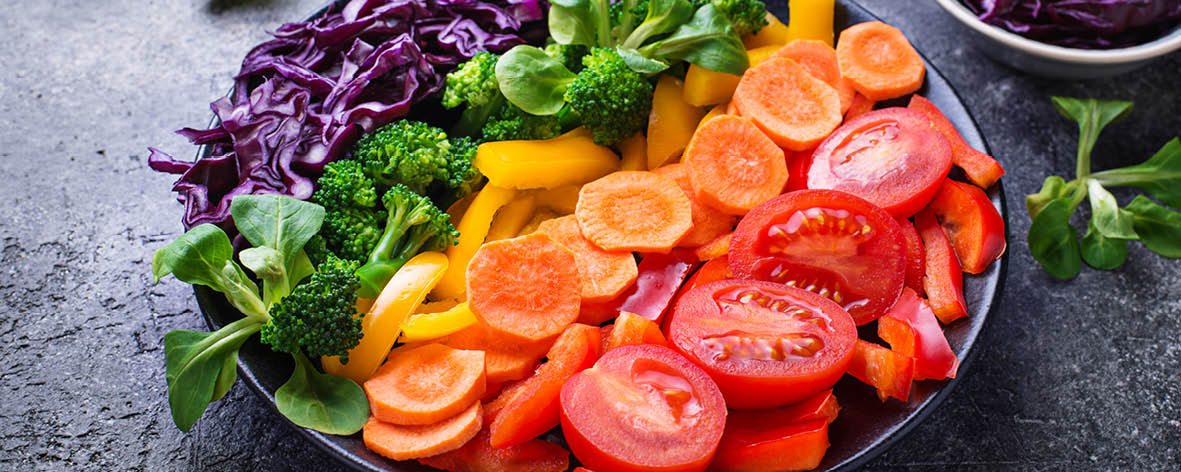Why you should eat a rainbow … yes, really!

We love winter, we really do but we have to be honest and say that sometimes the after-effects of a long winter can linger a little longer than we’d like. In particular, that feeling of fatigue and just generally being a bit run down is a real kicker when we’re now well into spring and want to be living our best lives. So, what’s the solution? Well obviously getting adequate rest is important, along with regular exercise which is great for the body and the mind, and there’s one other thing that you can do that will put some pep back into your step; eat a rainbow!
The Food Rainbow is a way to add a variety of healthy wholefoods to your diet by incorporating colourful foods each with their own health benefits. There are five different colour categories for fruits and vegetables, and each has their own unique set of phytochemicals. Phytochemicals give fruit and vegetables their unique colour, aroma and taste and each colour has its own health benefits, so when you eat a variety of colours (the rainbow) you’re eating a variety of vitamins and minerals which is excellent for your health.
Red fruits and vegetables contain a powerful antioxidant called lycopene that can reduce the risk of cancer and stroke, and supports heart health.
Try tomatoes, red capsicum, radishes, strawberries, raspberries, rhubarb, cherries, red grapes, watermelon, red apples, red onions.
Orange and yellow fruits and vegetables contain carotenoids, which are important for the immune system, skin and vision. They also reduce the risk of heart disease and inflammation.
Try carrots, pumpkin, apricots, yellow capsicum, sweet potato, pineapple, mangoes, yellow peaches, oranges, passionfruit, mandarins, nectarines, apricots, corn, grapefruit, tangerines.
Green fruits and vegetables contain carotenoids, indoles and saponins. These foods are usually high in potassium, fibre, vitamin K, antioxidants, and they contain folate which helps prevent neural tube defects in babies.
Try spinach, broccoli, green asparagus, peas, beans, green apples, green grapes, limes, kiwifruit, kale, silverbeet, celery, lettuce, cabbage, celery, cucumber, green capsicum, zucchini, avocado, green herbs, artichokes.
Brown and white fruits and vegetables contain flavonoids and phytochemicals such as allicin which has antiviral and antibacterial properties. White and brown fruits and vegetables can also help reduce cholesterol and blood pressure.
Try garlic, mushrooms, ginger, potatoes, cauliflower, brown onions, parsnip, turnip, bananas, dates, white peaches, brown pears, leeks.
Purple and blue fruits and vegetables get their colour from a plant pigment called anthocyanin. It has antioxidant properties to protect cells from damage and it is also known for improving brain health and memory.
Try blueberries, blackberries, eggplant, figs, red cabbage, purple grapes, beetroot, purple cauliflower, purple asparagus.
If you’re wondering how to include more of these foods into your diet, try these simple ideas:
· Add berries to your breakfast yoghurt or cereal, or make an omelette with spinach, mushrooms and red capsicum. Even a toastie can get the rainbow treatment with the addition of tomato, leafy greens and avocado.
· Add fruit and vegetables to your smoothies for an easy way to incorporate more of the rainbow.
· Serve a salad with lunch or dinner and fill it with colourful ingredients like lettuce, carrot, capsicum, cucumber, corn and tomato.
· Make a pot of vegetable soup packed with lots of vegetables.
· Change some of your usual recipes - instead of using green cabbage for coleslaw, try purple; instead of making potato chips, try sweet potato chips; instead of using red capsicum in a stir-fry, try green or yellow or all three; instead of having rice, try cauliflower rice; add veggies like carrot, zucchini and mushrooms to spaghetti sauce.
· Create a grazing platter or a rainbow fruit salad filled with a variety of fresh, colourful fruits for dessert.
· Mix up your shopping – instead of reaching for the same fruits and vegetables you always buy, grab a couple of new additions each week and incorporate them into your meals and snacks.
· Encourage your kids to eat a wide variety of fruit and vegetables by creating a rainbow poster. Each time they eat a colourful fruit or veggie they can colour a section of the rainbow. Challenge them to see if they can fill all sections of the rainbow within a week.

